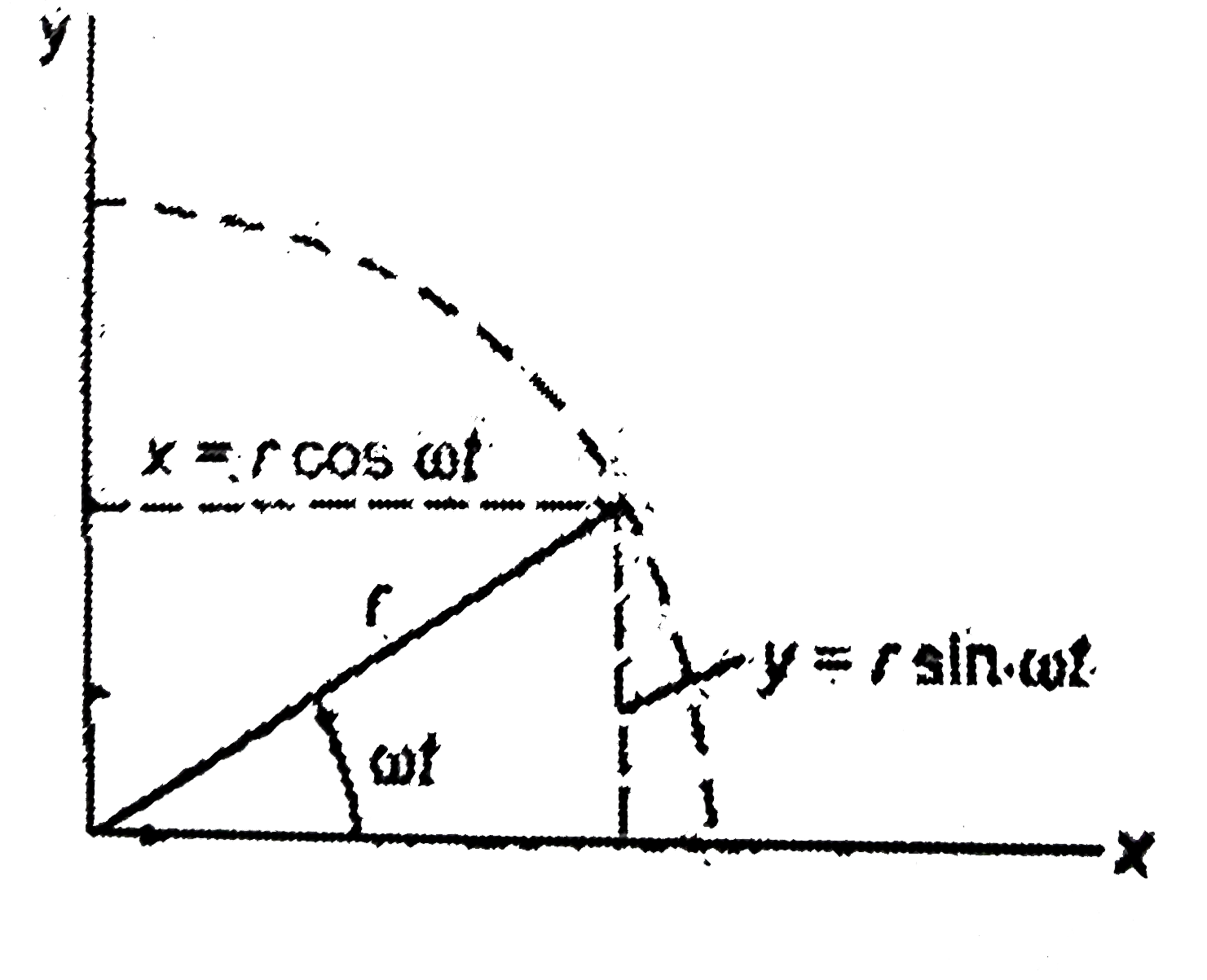For a particle moving in the x-y plane, the x and y coordinates are changing as x=a sin ωt and y=a(1−cosωt), where 'a' and ω constants. Then, what can be inferred for the trajectory of the particle ?
The trajectory is parabolic.
The trajectory is elliptical
The trajectory is such that distance moved by the particle is directly proportional to time.
The trajectory of the particle is equidistant from the origin at every instant of time.
The correct Answer is:C
To analyze the trajectory of a particle moving in the x-y plane with the given equations x=asin(ωt) and y=a(1−cos(ωt)), we can follow these steps:
Step 1: Identify the equations for x and y
We have:
- x=asin(ωt)
- y=a(1−cos(ωt))
Step 2: Express sin(ωt) and cos(ωt) in terms of x and y
From the equation for x:
sin(ωt)=xa
From the equation for y:
y=a(1−cos(ωt))⟹cos(ωt)=1−ya
Step 3: Use the Pythagorean identity
We know from trigonometry that:
sin2(θ)+cos2(θ)=1
Substituting our expressions for sin(ωt) and cos(ωt):
(xa)2+(1−ya)2=1
Step 4: Simplify the equation
Expanding the equation:
x2a2+(1−ya)2=1
x2a2+(1−2ya+y2a2)=1
Multiplying through by a2 to eliminate the denominators:
x2+(a2−2ay+y2)=a2
Rearranging gives:
x2+y2−2ay=0
Step 5: Identify the trajectory
Rearranging the equation:
x2+(y−a)2=a2
This is the equation of a circle with:
- Center at (0,a)
- Radius a
Conclusion
The trajectory of the particle is a circle centered at (0,a) with radius a.
We have:
- x=asin(ωt)
- y=a(1−cos(ωt))
From the equation for x:
sin(ωt)=xa
From the equation for y:
y=a(1−cos(ωt))⟹cos(ωt)=1−ya
We know from trigonometry that:
sin2(θ)+cos2(θ)=1
Substituting our expressions for sin(ωt) and cos(ωt):
(xa)2+(1−ya)2=1
Expanding the equation:
x2a2+(1−ya)2=1
x2a2+(1−2ya+y2a2)=1
Multiplying through by a2 to eliminate the denominators:
x2+(a2−2ay+y2)=a2
Rearranging gives:
x2+y2−2ay=0
Rearranging the equation:
x2+(y−a)2=a2
This is the equation of a circle with:
- Center at (0,a)
- Radius a
The trajectory of the particle is a circle centered at (0,a) with radius a.
Topper's Solved these Questions
- KINEMATICSBOOK - FIITJEECHAPTER - KINEMATICSEXERCISE - MCQ (MULTIPLE CORRECT)
15 Videos
- KINEMATICSBOOK - FIITJEECHAPTER - KINEMATICSEXERCISE - ASSERTION-REASON MCQ ( SINGLE CORRECT)
8 Videos
- KINEMATICSBOOK - FIITJEECHAPTER - KINEMATICSEXERCISE - SECTION (II) : (SUBJECTIVE )
33 Videos
- HEAT AND TEMPERATUREBOOK - FIITJEECHAPTER - HEAT AND TEMPERATUREEXERCISE - NUMERICAL BASES QUESTIONS
1 Videos
- LAWS OF MOTIONBOOK - FIITJEECHAPTER - LAWS OF MOTIONEXERCISE - COMPREHENSION-III
2 Videos
Similar Questions
A particle of mass 'm' is moving in the x−y plane such that its x and y coordinate very according to the law x=asinωt and y=acosωt where 'a' and 'ω' are positive constants and 't' is time. Find
(a) equation of the path. Name the trajectory (path)
(b) whether the particle moves in clockwise or anticlockwise direction
magnitude of the force on the particle at any time t.
View SolutionA particle of mass 'm' is moving in the x-y plane such that its x and y coordinate vary according to the law x= a sin ωt and y= a cos ωt where 'a' and 'omega' are positive constants and 't' is time. Find
(a) equation of the path. Name the trajectory (path).
(b) whether the particle moves in clockwise or anticlockwise direction
(c) magnitude of the force on the particle at any time t.
View Solution
Knowledge Check
A particle moves in the xy-plane according to the law x=asin(ωt)andy=a(1−cosωt) where 'a' and 'omega' are constants. Then the particle. follows :
Aa parabolic pathBa straight line path, equally inclined to x- and y-axisCcircular pathDa path such that distance moved by it is proportional to timeA particle moves in xy plane according to the law x = a sin ωtand y = a(1 – cosωt) where a and ω are constants. The particle traces
Aa parabolaBa straight line equallyinclined to x and y axesCa circleDa distance proportional to timeA particle moves in Xy plane according to the law X=asinωtandy=a(1−cosωt) where a and ω are constants. The particle traces-
Aa parabolaBa traight line equally inclined to X and y axesCa circleDa distance proportional to time
Consider a particle moving in the x−y plane according to r=r(cosωtˆi+sinωtˆj), where r and ω are constants. Find the trajectory, the velocity, and the acceleration.

View SolutionThe displacement of an oscillator is given by
x=asinωt+bcosωt
where a, b and ω, are constant. Then -
View SolutionA point moves in the plane xy according to the law, x=asinωt,y=a(1−cosωt) Answer the following question taking a and ω as positive constant
The equation of the trajectory of the particle is
View SolutionA point moves in the plane y according to the law x=Asinωt,y=Bcosωt, whereA,B&ω are positive constant.
The equation for trajectroy for path taken by particle is
View SolutionA particule moves in x - y plane acording to rule x = a sin ωt and y = a cos ωt. The particle follows
View Solution
